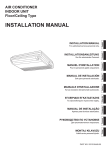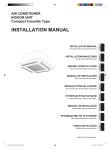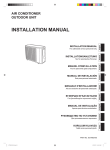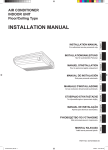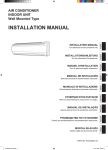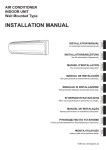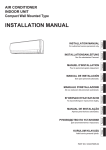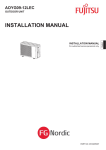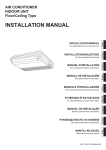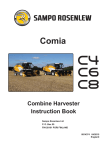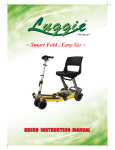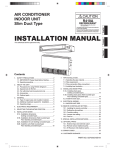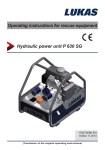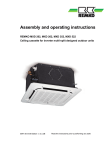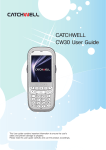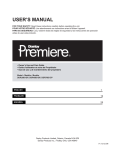Download INSTALLATION MANUAL
Transcript
AIR CONDITIONER INDOOR UNIT Compact Cassette Type Solo para personal autorizado. MANUALE D'INSTALLAZIONE Ad uso esclusivo del personale autorizzato. ΕΓΧΕΙΡΙΔΙΟ ΕΓΚΑΤΑΣΤΑΣΗΣ Για εξουσιοδοτημένο προσωπικό σέρβις. MANUAL DE INSTALAÇÃO Apenas para técnicos autorizados. РУКОВОДСТВО ПО УСТАНОВКЕ Для уполномоченного персонала. KURULUM KILAVUZU Yetkili servis personeli içindir. PART NO. 9379124010-05 Deutsch Français Español MANUAL DE INSTALACIÓN Italiano Pour le personnel agréé uniquement. EλληvIkά MANUEL D'INSTALLATION Português Nur für autorisiertes Personal. Русский INSTALLATIONSANLEITUNG Türkçe INSTALLATION MANUAL For authorized service personnel only. English INSTALLATION MANUAL INSTALLATION MANUAL PART No. 9379124010-05 INDOOR UNIT (Compact Cassette Type) Contents 1. SAFETY PRECAUTIONS........................................................................................... 1 2. ABOUT THE UNIT...................................................................................................... 1 2.1. Precautions for using R410A refrigerant ........................................................... 1 2.2. Special tool for R410A ...................................................................................... 1 2.3. Accessories ....................................................................................................... 1 2.4. Cassette grille accessories ............................................................................... 2 2.5. Optional parts.................................................................................................... 2 3. INSTALLATION WORK .............................................................................................. 2 3.1. Selecting an installation location ....................................................................... 2 3.2. Installation dimension ....................................................................................... 3 3.3. Installation the unit ............................................................................................ 3 4. PIPE INSTALLATION ................................................................................................. 5 4.1. Selecting the pipe material................................................................................ 5 4.2. Pipe requirement............................................................................................... 5 4.3. Flare connection (pipe connection) ................................................................... 5 4.4. Installing heat insulation.................................................................................... 6 5. ELECTRICAL WIRING ............................................................................................... 6 5.1. Wiring system diagram ..................................................................................... 7 5.2. Connection cable preparation ........................................................................... 8 5.3. Connection of wiring ......................................................................................... 8 6. REMOTE CONTROLLER SETTING .......................................................................... 8 6.1. Load batteries (R03/LR03 × 2) ......................................................................... 8 6.2. Installing the remote controller holder ................................................................ 9 7. CASSETTE GRILLE INSTALLATION......................................................................... 9 7.1. Remove the intake grille ................................................................................... 9 7.2. Installing the panel to indoor unit ...................................................................... 9 7.3. Attach the intake grille ..................................................................................... 10 The unit must be correctly earthed (grounded) and the supply line must be equipped with a differential breaker in order to protect the persons. The units are not explosion proof and therefore should not be installed in explosive atmosphere. Never touch electrical components immediately after the power supply has been turned off. Electric shock may occur. After turning off the power, always wait 5 minutes before touching electrical components. This unit contains no user-serviceable parts. Always consult authorized service personnel to repairs. When moving, consult authorized service personnel for disconnection and installation of the unit. This appliance is not intended for use by persons (including children) with reduced physical, sensory or mental capabilities, or lack of experience and knowledge, unless they have been given supervision or instruction concerning use of the appliance by a person responsible for their safety. Children should be supervised to ensure that they do not play with the appliance. 2. ABOUT THE UNIT 2.1. Precautions for using R410A refrigerant WARNING Do not introduce any substance other than the prescribed refrigerant into the refrigeration cycle. If air enters the refrigeration cycle, the pressure in the refrigeration cycle will become abnormally high and cause the piping to rupture. If there is a refrigerant leak, make sure that it does not exceed the concentration limit. If a refrigerant leak exceeds the concentration limit, it can lead to accidents such as oxygen starvation. Do not touch refrigerant that has leaked from the refrigerant pipe connections or other area. Touching the refrigerant directly can cause frostbite. If a refrigerant leak occurs during operation, immediately vacate the premises and thoroughly ventilate the area. If the refrigerant comes in contact with a Àame, it produces a toxic gas. 8. FUNCTION SETTING .............................................................................................. 10 8.1. Operation method ........................................................................................... 10 8.2. Function setting............................................................................................... 10 2.2. Special tool for R410A 8.3. Selecting the remote controller signal code .................................................... 11 8.4. Special installation methods ........................................................................... 12 9. TEST RUN................................................................................................................ 14 10. CHECK LIST ............................................................................................................ 14 11. OPTIONAL KIT INSTALLATION (OPTION).............................................................. 14 12. CUSTOMER GUIDANCE ......................................................................................... 14 WARNING To install a unit that uses R410A refrigerant, use dedicated tools and piping materials that have been manufactured speci¿cally for R410A use. Because the pressure of R410A refrigerant is approximately 1.6 times higher than the R22, failure to use dedicated piping material or improper installation can cause rupture or injury. Furthermore, it can cause serious accidents such as water leakage, electric shock, or ¿re. 13. ERROR CODES....................................................................................................... 15 Tool name Changes Gauge manifold The pressure in the refrigerant system is extremely high and cannot be measured with a conventional gauge. To prevent erroneous mixing of other refrigerants, the diameter of each port has been changed. It is recommended to use a gauge manifold with a high pressure display range of –0.1 to 5.3 MPa and a low pressure display range of –0.1 to 3.8 MPa. Charging hose To increase pressure resistance, the hose material and base size were changed. (The charging port thread diameter for R410A is 1/2 UNF 20 threads per inch.) Vacuum pump A conventional vacuum pump can be used by installing a vacuum pump adapter. Be sure that the pump oil does not back Àow into the system. Use one capable for vacuum suction of –100.7 kPa (5 Torr, –755 mmHg). 1. SAFETY PRECAUTIONS • Be sure to read this Manual thoroughly before installation. • The warnings and precautions indicated in this Manual contain important information pertaining to your safety. Be sure to observe them. • Hand this Manual, together with the Operating Manual, to the customer. Request the customer to keep them on hand for future use, such as for relocating or repairing the unit. WARNING This mark indicates procedures which, if improperly performed, might lead to the death or serious injury of the user. Request your dealer or a professional installer to install the indoor unit in accordance with this Installation Manual. An improperly installed unit can cause serious accidents such as water leakage, electric shock, or ¿re. If the indoor unit is installed in disregard of the instructions in the Installation Manual, it will void the manufacturer’s warranty. Do not turn ON the power until all work has been completed. Turning ON the power before the work is completed can cause serious accidents such as electric shock or ¿re. If refrigerant leaks while work is being carried out, ventilate the area. If the refrigerant comes in contact with a Àame, it produces a toxic gas. Installation work must be performed in accordance with national wiring standards by authorized personnel only. CAUTION This mark indicates procedures which, if improperly performed, might possibly result in personal harm to the user, or damage to property. Read carefully all security information before use or install the air conditioner. Do not attempt to install the air conditioner or a part of the air conditioner by yourself. This unit must be installed by quali¿ed personnel with a capacity certi¿cate for handling refrigerant Àuids. Refer to regulation and laws in use on installation place. The installation must be carried out in compliance with regulations in force in the place of installation and the installation instructions of the manufacturer. This unit is part of a set constituting an air conditioner. It must not be installed alone or with non-authorized by the manufacturer. Always use a separate power supply line protected by a circuit breaker opera-ting on all wires with a distance between contact of 3mm for this unit. En-1 Gas leakage detector Special gas leakage detector for R410A refrigerant. 2.3. Accessories WARNING For installation purposes, be sure to use the parts supplied by the manufacturer or other prescribed parts. The use of non-prescribed parts can cause serious accidents such as the unit to fall, water leakage, electric shock, or ¿re. • The following installation parts are furnished. Use them as required. • Keep the Installation Manual in a safe place and do not discard any other accessories until the installation work has been completed. Name and Shape Q’ty Description 2.4. Cassette grille accessories Operating Manual Name and Shape Q’ty Connector cover 1 Description For covering connector 1 Installation Manual (This book) Tapping Screw (M5 × 12 mm) For mounting cassette grille 4 1 Tapping Screw (M4 × 12 mm) For mounting connector cover 1 For indoor side pipe joint (Gas pipe) Coupler heat insulation (Large) 1 L angle 2 Coupler heat insulation (Small) 1 For indoor side pipe joint (Liquid pipe) Hook wire Special nut A (Large Àange) For suspending the Cassette grille 2 For installing indoor unit 4 Special nut B (Small Àange) For mounting the Hook Wire to the Cassette grille Screw [pitch small] (M4 × 10 mm) For mounting the Hook Wire (for metals) 2 For installing indoor unit 4 For ceiling openings cutting Also used as packing Template (Carton top) Screw [pitch large] (M4 × 10 mm) 4 For mounting the L angle and Hook wire (for resins) 1 Drain hose For installing drain pipe VP25 (O.D.32, I.D.25) 2.5. Optional parts 1 Parts name Hose Band For installing drain hose Model No. Summary Wired remote controller UTY-RNN*M Unit control is performed by wired remote controller Simple Remote Controller UTY-RSN*M For air conditioner operation Air outlet shutter plate UTR-YDZB Install the plate at outlet when carrying out 3-way direction operation Insulation kit for High humidity UTZ-KXGC External connect kit UTY-XWZX For control input/output port Fresh air intake kit UTZ-VXAA To take fresh air 1 For installing drain pipe Drain hose insulation 1 Remote controller For air conditioner operation 1 Battery For remote controller unit Wired remote controller is recommended using simultaneous twin or triple connection. 2 3. INSTALLATION WORK For installing the remote controller Remote controller holder Especially, the installation place is very important for the split type air conditioner because it is very dif¿cult to move from place to place after the ¿rst installation. 1 3.1. Selecting an installation location Tapping screw (M3 × 12mm) 2 For mounting the remote controller holder Decide the mounting position together with the customer as follows. WARNING Cable-tie For electrical wiring 2 Select installation locations that can properly support the weight of the indoor unit. Install the units securely so that they do not topple or fall. For electrical wiring Wire clamper 1 (*1) This part is not furnished for AUT* series En-2 • For a 3-way outlet, make sure to perform the Function Setting on the remote control. Also, make sure to use the optional shutter plate to block the outlet. CAUTION Do not install the indoor unit in the following areas: • Area with high salt content, such as at the seaside. It will deteriorate metal parts, causing the parts to fail or the unit to leak water. • Area ¿lled with mineral oil or containing a large amount of splashed oil or steam, such as a kitchen. It will deteriorate plastic parts, causing the parts to fail or the unit to leak water. • Area that generates substances that adversely affect the equipment, such as sulfuric gas, chlorine gas, acid, or alkali. It will cause the copper pipes and brazed joints to corrode, which can cause refrigerant leakage. • Area that can cause combustible gas to leak, contains suspended carbon ¿bers or Àammable dust, or volatile inÀammables such as paint thinner or gasoline. If gas leaks and settles around the unit, it can cause a ¿re. • Area where animals may urinate on the unit or ammonia may be generated. Do not install where there is the danger of combustible gas leakage. Do not install the unit near a source of heat, steam, or Àammable gas. Install the indoor unit, outdoor unit, power supply cable, transmission cable, and remote control cable at least 1 m away from a television or radio receivers. The purpose of this is to prevent TV reception interference or radio noise. (Even if they are installed more than 1 m apart, you could still receive noise under some signal conditions.) • The ceiling height cannot be set in the 3-way outlet mode. Therefore, do not change the setting in the setting the ceiling height. (See 8.2. FUNCTION SETTING) • When the outlet is shut, be sure to install the optional Air outlet shutter plate kit. For the details of installation, please refer to Installation Manual of kit. 3.3. Installation the unit WARNING Install the air conditioner in a location which can withstand a load of at least 5 times the weight of the main unit and which will not amplify sound or vibration. If the installation location is not strong enough, the indoor unit may fall and cause injuries. If the job is done with the panel frame only, there is a risk that the unit will come loose. Please take care. 3.3.1. Position the ceiling hole and hanging bolts Ceiling openings and hanging bolt installation diagram. If children under 10 years old may approach the unit, take preventive measures so that they cannot reach the unit. WARNING When fastening the hangers, make the bolt positions uniform. 150~200 3.2. Installation dimension • The ceiling rear height as shown in the ¿gure. 250 700 (Cassette Grille) 570(Indoor unit) 580 – 660 (Ceiling openings) 540 (Hanging bolt position) 530 (Hanging bolt position) 75 (1) Install the indoor unit in a location having suf¿cient strength to support the weight of the indoor unit. (2) The inlet and outlet ports should not be obstructed; the air should be able to blow all over the room. (3) Leave the space required to service the air conditioner. (4) Locate where the air can be distributed evenly throughout the room by the unit. (5) Install the unit where connection to the outdoor unit is easy. (6) Install the unit where the connection pipe can be easily installed. (7) Install the unit where the drain pipe can be easily installed. (8) Install the unit where noise and vibration is not ampli¿ed. (9) Take servicing, etc., into consideration and leave the spaces. Also install the unit where the ¿lter can be removed. 250 262 or more Min.450 Strong and durable ceiling service access 1,000 or more • This product can be installed at a height of up to 3,000mm. However, 7000, 9000 Btu/h model can not be installed in high places. Perform the Function Setting on the remote control in accordance with the installed height. (See 8.2.Function setting) 262 215 114 Unit : mm Floor 30 Obstruction Control box Ceiling Liquid pipe Gas pipe 30 58 123 1,800 or more 1,000 or more Min.450 Drain pipe (O.D.ø26.1) 102 99 40 Unit : mm Discharge direction setting • The discharge direction can be selected as shown below. Be sure to keep suf¿cient space in the designated position for future maintenance. 100 or more* 3.3.2. Body installation *Please ensure suf¿cient service access during installation. (1) Install special nut A, then special nut B onto the hanging bolt. (2) Raise the body and mount its hooks onto the hanging bolt between the special nuts. (3)Turn special nut B to adjust the height of the body. WARNING Perform ¿nal tightening by tightening the double nut ¿rmly. Be sure to install the body horizontally and adjust the height below the body and the ceiling surface properly. (4 directions) (3 directions) Unit : mm En-3 Special nut A Hook Special nut B 30 or more Hanging bolt Downward gradient 1/100 to 1/50 300 mm or less After installing the body, tighten the nuts. VP25 (O.D. 32 mm) local arrangement 700 mm or less Horizontal or upward gradient Ceiling Unit : mm VP30 (O.D. 38 mm) or more Downward gradient 1/100 to 1/50 700 mm or less 3.3.3. Leveling Using a level, or vinyl hose ¿lled with water, ¿ne adjust so that the body is level. Inclined installation so as the drain pipe side is higher may cause a malfunction of the Àoat switch, and may cause water leakage. Drain pipe Installation procedure Vinyl hoses 3.3.4. Installing drain pipe WARNING Do not insert the drain piping into the sewer where sulfurous gas occurs. (Heat exchange erosion may occur) 1) Install the attached drain hose to the drain port of the body. Install the hose band from the top of the hose within the shown in the ¿gure area. 2) Use vinyl adhesive agent to glue the drain piping (PVC pipe VP25 ) to the drain hose assembly. (Apply color adhesive agent evenly until the gauge line and seal) 3) Check the drainage. (See separate diagram) 4) Install the heat insulation. 5) Use the attached heat insulation to insulate the drain port and hose band. Attach hose band (Accessories) Insulate the parts properly so that water will not drip from the connection parts. Check for proper drainage after installation by using the visible portion of transparent drain port and the drain piping ¿nal outlet on the body. Install the knob facing upward Locally installed PCV pipe CAUTION Attach drain hose (Accessories) Do not apply adhesive agent on the drain port of the body. (Use the attached drain hose assembly to connect the drain piping) Note: Install the drain pipe. • Install the drain pipe with downward gradient (1/50 to 1/100) and so there are no rises or traps in the pipe. • Use general hard polyvinyl chloride pipe (VP25) [outside diameter 32mm] and connect it with adhesive (polyvinyl chloride) so that there is no leakage. • When the pipe is long, install supporters. • Do not perform air bleeding. • Always heat insulate indoor section of drain pipe. • If it is impossible to have suf¿cient gradient of pipe, perform drain lift-up. Pipe size Drain pipe Attach heat insulation (Accessories) (a) Top view (b) Side view VP25 (O.D. 32 mm) Hanging ¿ttings Unit: mm Hose band 1.5 to 2 m 5~10 19 Applying area of adhesive 35 20 Gauge line VP25 (O.D. 32 mm) Downward gradient 1/100 to 1/50 (c) Hose opening view PROHIBITED: Wind the attached heat insulation around the hose band Rise 4 or less 20 Transparent visible portion Trap Air bleeding Top view Make sure the alignment is on top When lifting up drain: • Height of inclined pipe should be less than 700 mm from the ceiling. A rise dimension over this range will cause leakage. Make sure there are no gaps • Lift up the pipe vertically at the position of 300 mm or less from the unit. Note) Check for drainage Pour about 1 liter of water from the position (see 9. TEST RUN/CHECKING DRAINAGE). Check for any abnormalities such as strange noises and whether the drain pump functions normally En-4 4. PIPE INSTALLATION Check if [L] is Àared uniformly and is not cracked or scratched. B CAUTION Die Be careful that foreign matter (oil, water, etc.) does not enter the piping with refrigerant R410A models. Also, when storing the piping, securely seal the openings by pinching, taping, etc. A L Pipe While brazing the pipes, be sure to purge with dry nitrogen gas. Pipe outside diameter [mm (in.)] 4.1. Selecting the pipe material CAUTION Do not use existing pipes. Use pipes that have clean external and internal sides without any contamination which may cause trouble during use, such as sulfur, oxide, dust, cutting waste, oil or water. It is necessary to use seamless copper pipes. Material: Phosphor deoxidized seamless copper pipes. It is desirable that the amount of residual oil is less than 40 mg/10 m. Do not use copper pipes that have a collapsed, deformed, or discolored portion (especially on the interior surface). Otherwise, the expansion valve or capillary tube may become blocked with contaminants. Dimension A [mm] Flare tool for R410A, clutch type 0 Dimension B-0.4 [mm] 6.35 (1/4) 9.1 9.52 (3/8) 13.2 0 to 0.5 12.70 (1/2) 16.6 15.88 (5/8) 19.7 19.05 (3/4) 24.0 When using conventional Àare tools to Àare R410A pipes, the dimension A should be approximately 0.5 mm more than indicated in the table (for Àaring with R410A Àare tools) to achieve the speci¿ed Àaring. Use a thickness gauge to measure the dimension A. Width across Àats Improper pipe selection will degrade performance. As an air conditioner using R410A incurs pressure higher than when using conventional refrigerant, it is necessary to choose adequate materials. • Thicknesses of copper pipes used with R410A are as shown in the table. • Never use copper pipes thinner than those indicated in the table even if they are available on the market. Pipe outside diameter [mm (in.)] Width across Àats of Flare nut [mm] 6.35 (1/4) 17 9.52 (3/8) 22 12.70 (1/2) 26 15.88 (5/8) 29 19.05 (3/4) 36 4.3.2 Bending pipes Thicknesses of Annealed Copper Pipes (R410A) Pipe outside diameter [mm (in.)] Thickness [mm] 6.35 (1/4) 0.80 9.52 (3/8) 0.80 12.70 (1/2) 0.80 15.88 (5/8) 1.00 19.05 (3/4) 1.20 • If pipes are shaped by hand, be careful not to collapse them. • Do not bend the pipes at an angle more than 90°. • When pipes are repeatedly bend or stretched, the material will harden, making it dif¿cult to bend or stretch them any more. • Do not bend or stretch the pipes more than 3 times. CAUTION To prevent breaking of the pipe, avoid sharp bends. If the pipe is bent repeatedly at the same place, it will break. 4.2. Pipe requirement CAUTION 4.3.3. Pipe connection Refer to the Installation Manual of the outdoor unit for description of the length and the diameter of connecting pipe or for difference of its elevation. • Use pipe with water-resistant heat insulation. CAUTION Install heat insulation around both the gas and liquid pipes. Failure to do so may cause water leaks. Use heat insulation with heat resistance above 120 °C. (Reverse cycle model only) In addition, if the humidity level at the installation location of the refrigerant piping is expected to exceed 70%, install heat insulation around the refrigerant piping. If the expected humidity level is 70-80%, use heat insulation that is 15 mm or thicker and if the expected humidity exceeds 80%, use heat insulation that is 20 mm or thicker. If heat insulation is used that is not as thick as speci¿ed, condensation may form on the surface of the insulation. In addition, use heat insulation with heat conductivity of 0.045W/(m·K) or less (at 20 °C). 4.3. Flare connection (pipe connection) 4.3.1. Flaring • Use special pipe cutter and Àare tool exclusive for R410A. (1) Cut the connection pipe to the necessary length with a pipe cutter. (2) Hold the pipe downward so that cuttings will not enter the pipe and remove any burrs. (3) Insert the Àare nut (always use the Àare nut attached to the indoor and outdoor units respectively) onto the pipe and perform the Àare processing with a Àare tool. Leakage of refrigerant may result if other Àare nuts are used. (4) Protect the pipes by pinching them or with tape to prevent dust, dirt, or water from entering the pipes. En-5 CAUTION Be sure to connect the pipe against the port on the indoor unit and the outdoor unit correctly. If the centering is improper, the Àare nut cannot tightened smoothly. If the Àare nut is forced to turn, the threads will be damaged. Do not remove the Àare nut from the indoor unit pipe until immediately before connecting the connection pipe. Do not use mineral oil on Àared part. Prevent mineral oil from getting into the system as this would reduce the lifetime of the units. (1) Detach the caps and plugs from the pipes. (2) Center the pipe against the port on the indoor unit, and then turn the Àare nut by hand. Connection pipe (Gas) Connection pipe (Liquid) Indoor unit (3) When the Àare nut is tightened properly by your hand, hold the body side coupling with a separate spanner, then tighten with a torque wrench. (See the table below for the Àare nut tightening torques. CAUTION Hold the torque wrench at its grip, keeping it in the right angle with the pipe, in order to tighten the Àare nut correctly. Tighten the Àare nuts with a torque wrench using the speci¿ed tightening method. Otherwise, the Àare nuts could break after a prolonged period, causing refrigerant to leak and generate a hazardous gas if the refrigerant comes into contact with a Àame. Tighten with 2 wrenches. Flare nut Indoor unit pipe (Body side) Match the terminal block numbers and connection cable colors with those of the outdoor unit or branch box. Erroneous wiring may cause burning of the electric parts. Securely connect the connection cables to the terminal blocks. In addition, secure the cables with wiring holders. Improper connections, either in the wiring or at the ends of the wiring, can cause a malfunction, electric shock, or ¿re. Always fasten the outside covering of the connection cable with the cable clamp. (If the insulator is chafed, electric leakage may occur.) Securely install the electrical box cover on the unit. An improperly installed electrical box cover can cause serious accidents such as electric shock or ¿re through exposure to dust or water. Holding wrench Torque wrench Do not modify the power cables, use extension cables, or use any branches in the wiring. Improper connections, insuf¿cient insulation, or exceeding the allowable current can cause electric shock or ¿re. Install sleeves into any holes made in the walls for wiring. Otherwise, a short circuit could result. Install a earth (ground) leakage breaker. In addition, install the earth (ground) leakage breaker so that the entire AC main power supply is cut off at the same time. Otherwise, electric shock or ¿re could result. Connection pipe Flare nut [mm (in.)] Tightening torque [N·m (kgf·cm)] 6.35 (1/4) dia. 16 to 18 (160 to 180) 9.52 (3/8) dia. 32 to 42 (320 to 420) 12.70 (1/2) dia. 49 to 61 (490 to 610) 15.88 (5/8) dia. 63 to 75 (630 to 750) 19.05 (3/4) dia. 90 to 110 (900 to 1,100) 4.4. Installing heat insulation CAUTION Always connect the earth (ground) wire. Improper earthing (grounding) work can cause electric shocks. Install the remote controller cable and bus wire so as not to be direct touched with your hand. (1) Use ring terminals with insulating sleeves as shown in the ¿gure below to connect to the terminal block. (2) Securely clamp the ring terminals to the wires using an appropriate tool so that the wires do not come loose. (3) Use the speci¿ed wires, connect them securely, and fasten them so that there is no stress placed on the terminals. (4) Use an appropriate screwdriver to tighten the terminal screws. Do not use a screwdriver that is too small, otherwise, the screw heads may be damaged and prevent the screws from being properly tightened. (5) Do not tighten the terminal screws too much, otherwise, the screws may break. (6) See the table 1 for the terminal screw tightening torques. After checking for gas leaks (refer to the Installation Manual of the outdoor unit), perform this section. Install heat insulation around both the large (gas) and small (liquid) pipes. Failure to do so may cause water leaks. ip Str 10 mm Ring terminal After checking for gas leaks, insulate by wrapping insulation around the 2 parts (gas and liquid) of the indoor unit coupling, using the Coupler Heat Insulation. After installing the Coupler Heat Insulation, wrap both ends with vinyl tape so that there is no gap. Sleeve Screw with special washer Coupler heat insulation Body Screw with special washer Ring terminal No gap Wire Wire Coupler heat insulation Be sure to overlap the insulation Ring terminal Terminal board CAUTION Terminal block Must ¿t tightly against body without any gap. Table 1 5. ELECTRICAL WIRING Tightening torque Cable Cable size (mm2) Type Remarks Connection cable 1.5 (MIN.) Type 60245 IEC57 3Cable+Earth (Ground), 1ij230V Max. Cable Length: Limit voltage drop to less than 2%. Increase cable gauge if voltage drop is 2% or more. M4 screw 1.2 to 1.8 N·m (12 to 18 kgf·cm) WARNING Use crimp-type terminals and tighten the terminal screws to the speci¿ed torques, otherwise, abnormal overheating may be produced and possibly cause heavy damage inside the unit. For simultaneous multi Bus wire Conductor size (mm2) Max length (m) 0.3 (MIN.) 500* *This length shall be the total extended length in the system of the group. (Total length of bus wire and remote controller cable.) WARNING Electrical work must be performed in accordance with this Manual by a person certi¿ed under the national or regional regulations. Be sure to use a dedicated circuit for the unit. An insuf¿cient power supply circuit or improperly performed electrical work can cause serious accidents such as electric shock or ¿re. Before starting work, check that power is not being supplied to the indoor unit and outdoor unit. Use the included transmission cables and power cables or ones speci¿ed by the manufacturer. Improper connections, insuf¿cient insulation, or exceeding the allowable current can cause electric shock or ¿re. For wiring, use the prescribed type of wires, connect them securely, making sure that there are no external forces of the wires applied to the terminal connections. Improperly connected or secured wires can cause serious accidents such as overheating the terminals, electric shock, or ¿re. En-6 Simultaneous twin (18, 22, 24 type only) 5.1. Wiring system diagram Connection cable Indoor unit (Primary) Connection diagrams Junction box (Local purchase) Earth (Ground) line Outdoor unit Standard pair Connection cable Indoor unit Outdoor unit Earth (Ground) line Power line Earth (Ground) line Indoor unit (Secondary) Control line Power line Control line Wired remote controller cable Wired remote controller Indoor unit * Red White Black Indoor unit * R W B Wired remote controller cable Wired remote controller Indoor unit (Primary) * Red White Black Remote controller cable *Earth (Ground) the remote controller if it has a earth (ground) line. Indoor unit (Secondary) Flexible multi Connection cable Indoor unit Earth (Ground) line R W B * Remote controller cable Bus wire (Local purchase) Outdoor unit Power line UNIT A *Earth (Ground) the remote controller if it has a earth (ground) line. • Connect the remote controller wires to the primary unit. Control line Indoor unit Simultaneous triple (18 type only) Connection cable Indoor unit (Primary) UNIT B Wired remote controller cable Indoor unit Wired remote controller * Indoor unit (Secondary) * Red White Black Remote controller cable *Earth (Ground) the remote controller if it has a earth ground) line. Indoor unit (Secondary) Flexible multi (branch box) OUTDOOR UNIT INDOOR UNIT A Control line Power line Indoor unit Outdoor unit Control line Power line INDOOR UNIT B Wired remote controller cable Indoor unit Wired remote controller * Red White Black Remote controller cable *Earth (Ground) the remote controller if it has a earth ground) line. En-7 Outdoor unit Earth (Ground) line Control line Power line R W B Connection cable Indoor unit Earth (Ground) line Branch box Junction box (Local purchase) Earth (Ground) line R W B * Wired remote controller cable Indoor unit (Primary) Wired remote controller * Red White Black Indoor unit (Secondary) R W B (2) After wiring is complete, secure the remote controller cable and transmission cable with the attached the cable-tie and the clamper. * Wire clamper (accessory) Bind securely Remote controller cable Transmission cable Detail(a) (a) Bus wire ( Local purchase ) Wired remote controller cable (option) Indoor unit (Secondary) *Earth (Ground) the remote controller if it has a earth (ground) line. • Connect the remote controller wires to the primary unit. Wired remote controller is recommended using simultaneous twin or triple connection. CAUTION Thread the cable-tie through the hole and tighten securely Tighten the indoor unit connection cable and power supply indoor and outdoor unit, branch box terminal board connections ¿rmly with the terminal board screws. Faulty connection may cause a ¿re. cable-tie (accessory) Cut of the excess If the indoor unit connection cable and power supply are wired incorrectly, the air conditioner may be damaged. Connect the indoor unit connection cable by matching the numbers of the outdoor, branch box and indoor units terminal board numbers as shown in terminal label. Wire clamper (accessory) Bind securely Earth (Ground) both the indoor and outdoor, branch box units by attaching an earth (ground) cable. cable-tie (accessory) Cut of the excess Unit shall be earthed (grounded) in compliance with the applicable local and national cables. Transmission cable Wired remote controller cable (option) CAUTION Be sure to refer to the above diagram for do correct ¿eld wiring. Wrong wiring causes malfunction of the unit. Thread the cable-tie through the hole and tighten securely (3) Install control box cover. Check local electrical rules and also any speci¿c wiring instructions or limitation. CAUTION Do not wire the remote controller cable together with or parallel to the connection cables, and power supply cables of the INDOOR UNIT and OUTDOOR UNIT, BRANCH BOX. It may cause erroneous operation. 5.2. Connection cable preparation Keep the earth (ground) wire longer than the other wires. . 20 mm 6. REMOTE CONTROLLER SETTING Earth (ground) wire mm or ore Power supply cable or connection cable Refer to the installation manual enclosed with the remote controller when the wired remote controller (option ) is used. m 40 6.1. Load batteries (R03/LR03 × 2) • Use a 4-core wire cable. 5.3. Connection of wiring (1) Remove the control box cover and install each connection wire. Screw (1) Press and slide the battery compartment lid on the reverse side to open it. Slide in the mark. direction of the arrow while pressing the (2) Insert batteries. Be sure to align the battery polarities ( ) correctly. (3) Close the battery compartment lid. Control box cover En-8 CAUTION (2) Open the intake grille and remove. Take care to prevent infants from accidentally swallowing batteries. When not using the Remote Controller for an extended period, remove the batteries to avoid possible leakage and damage to the unit. If leaking battery Àuid comes in contact with your skin, eyes, or mouth, immediately wash with copious amounts of water, and consult your physician. Dead batteries should be removed immediately and disposed of properly, either in a battery collection receptacle or to the appropriate authority. Do not attempt to recharge dry batteries. NOTE • Never mix new and used batteries, or batteries of different types. • Batteries should last about 1 year under normal use. If the Remote Controller’s operating range becomes appreciably reduced, replace the batteries and press the RESET button with the tip of a ballpoint pen or other small object. 6.2. Installing the remote controller holder CAUTION 7.2. Installing the panel to indoor unit (1) Install the cassette grille on the indoor unit. “DRAIN” mark Check that the indoor unit correctly receives the signal from the remote controller, then install the remote controller holder. “PIPE” mark Select the remote controller holder selection site by paying careful attention to the following: Avoid places in direct sunlight. Select a place that will not be affected by the heat from a stove, etc. • Install the remote controller with a distance of 7 m between the remote controller and the photocell as the criteria. However, when installing the remote controller, check that it operates positively. • Install the remote controller holder to a wall, pillar, etc., with the tapping screw. • Align the stamped marks on the cassette grille to the pipe and the drain of the indoor unit. (1) Mount the holder. Screws (2) Set the remote controller. Insert Press in (3) To remove the remote controller (when use at hand). Slide up Pull out 7. CASSETTE GRILLE INSTALLATION 7.1. Remove the intake grille (1) Slide the 2 grille hooks. Screw CAUTION Use only the supplied screws to install the cassette grille. Indoor unit Sealant 5~7 • Installation according to the Installation instruction sheet Cassette grille. • Be sure to con¿rm there is no gap between the panel and main unit after installing the Cassette grille. Ceiling Cassette grille No gap between ceiling and cassette grille around entire perimeter Grille hook En-9 (2) Connect the connector. (3) Press the MODE button to accept the signal code, and proceed to STEP 2. Wire (display): WHITE Wire (louver): WHITE Wire (louver): RED Indoor unit side • Arrange the wires as illustrated below. (3) Attach the connector cover. Screw Connector cover The air conditioner signal code is factory-set to A . Contact your retailer to change the signal code. The remote controller resets to signal code A when the batteries in the remote controller are replaced. If you use a signal code other than signal code A, reset the signal code after replacing the batteries. If you do not know the air conditioner signal code setting, try each of the signal codes ) until you ¿nd the code which operates the air conditioner. ( 7.3. Attach the intake grille The installation is the reverse of “REMOVING THE INTAKE GRILLE”. The intake grille can be rotated and installed 4 ways to suit the user’s preference. CAUTION The louver angle cannot be changed if the power is not on. (If moved by hand, it may be damaged.) The grille assembly is directionally relative to the air conditioner body. Install so that there is no gap between the grille assembly and the air conditioner body. The cassette grille equips with an accessory to prevent the grill completely open. Be sure to read the INSTALLATION SHEET included with the cassette grille before installation. STEP 2 Selecting the Function Number and Setting Value (1) Press the SET TEMP. ( ) ( ) buttons to select the function number. (Press the MODE button to switch between the left and right digits.) (2) Press the FAN button to proceed to setting the value. (Press the FAN button again to return to the function number selection.) (3) Press the SET TEMP. ( ) ( ) buttons to select the setting value. (Press the MODE button to switch between the left and right digits.) (4) Press the TIMER MODE button, and START/STOP button, in the order listed to con¿rm the settings. (5) Press the RESET button to cancel the function setting mode. (6) After completing the FUNCTION SETTING, be sure to turn off the power and turn it on again. 8. FUNCTION SETTING Function number CAUTION Con¿rm whether the wiring work for outdoor unit has been ¿nished. Setting value Con¿rm whether the cap for electric control box on the outdoor unit is close. • This procedure changes to the function settings used to control the indoor unit according to the installation conditions. Incorrect settings can cause the indoor unit malfunction. • After the power is turned on, perform the “FUNCTION SETTING” according to the installation conditions using the remote controller. • The settings may be selected between the following two: Function Number or Setting Value. • Settings will not be changed if invalid numbers or setting values are selected. • Refer to the installation manual enclosed with the remote controller when the wired remote controller (option) is used. CAUTION 8.1. Operation method • While pressing the FAN button and SET TEMP. ( button to enter the function setting mode. ) simultaneously, press the RESET STEP 1 Selecting the Remote Controller Signal Code Use the following steps to select the signal code of the remote controller. (Note that the air conditioner cannot receive a signal code if the air conditioner has not been set for the signal code.) The signal codes that are set through this process are applicable only to the signals in the FUNCTION SETTING. For details on how to set the signal codes through the normal process, refer to SELECTING THE REMOTE CONTROLLER SIGNAL CODE. After turning off the power, wait 30 seconds or more before turning on it again. The FUNCTION SETTING doesn’t become effective if it doesn’t do so. 8.2. Function setting (1) Filter sign The indoor unit has a sign to inform the user that it is time to clean the ¿lter. Select the time setting for the ¿lter sign display interval in the table below according to the amount of dust or debris in the room. If you do not wish the ¿lter sign to be displayed, select the setting value for “No indication”. (1) Press the SET TEMP. ( ) ( ) button to change the signal code between . Match the code on the display to the air conditioner signal code. (initially set to ) (If the signal code does not need to be selected, press the MODE button and proceed to STEP 2.) (2) Press the TIMER MODE button and check that the indoor unit can receive signals at the displayed signal code. En-10 (¡... Factory setting) Setting description Function number Setting value 00 Standard (2,500 hours) Long interval (4,400 hours) ¡ * If setting value is “00”: Room temperature is controlled by the indoor unit temperature sensor. * If setting value is “01”: Room temperature is controlled by either indoor unit temperature sensor or remote controller unit sensor. 01 11 (8) Wireless remote controller signal code Short interval (1,250 hours) 02 No indication 03 Change the indoor unit Signal Code, depending on the wireless remote controllers. (¡... Factory setting) Setting description Function number Setting value A B C D 44 00 01 02 03 ¡ (2) Ceiling height Select the setting values in the table below according to the height of the ceiling. (¡... Factory setting) Setting description ¡ Function number Standard (2.7 m [9 ft]) Setting value 00 20 High ceiling (3.0 m [10 ft]) 01 * However, 7000, 9000 Btu/h model can not be installed in high places. (9) External input control “Operation/Stop” mode or “Forced stop” mode can be selected. (¡... Factory setting) ¡ (3) Outlet directions Select the setting values in the table below for using a 3-way outlet. Setting description Function number Setting value Operation/Stop mode (Setting forbidden) Forced stop mode 46 00 01 02 (¡... Factory setting) Setting description Function number Setting value 4-way 3-way 22 00 01 ¡ Setting record x Record any changes to the settings in the following table. Setting Setting Value (1) Filter sign (4) Cooling room temperature correction Depending on the installed environment, the room temperature sensor may require a correction. The settings may be selected as shown in the table below. (¡... Factory setting) Setting description ¡ Function number Setting value 30 00 01 02 03 Standard Slightly lower control Lower control Warmer control (2) Ceiling height (3) Outlet directions (4) Cooler room temperature correction (5) Heater room temperature correction (6) Auto restart (7) Indoor room temperature sensor switching function (8) Wireless remote controller signal code (9) External input control (5) Heating room temperature correction Depending on the installed environment, the room temperature sensor may require a correction. The settings may be changed as shown in the table below. (¡... Factory setting) Setting description ¡ Standard Lower control Slightly warmer control Warmer control Function number Setting value 31 00 01 02 03 (6) Auto restart Enable or disable automatic system restart after a power outage. (¡... Factory setting) ¡ Setting description Function number Setting value Yes No 40 00 01 * Auto restart is an emergency function such as for power failure etc. Do not start and stop the indoor unit by this function in normal operation. Be sure to operate by the control unit, or external input device. (7) Indoor room temperature sensor switching function (Only for Wired remote controller) The following settings are needed using the Wired remote controller temperature sensor (¡... Factory setting) ¡ En-11 Setting description Function number Setting value No Yes 42 00 01 After completing the FUNCTION SETTING, be sure to turn off the power and turn it on again. 8.3. Selecting the remote controller signal code [When using the wireless remote controller] When 2 or more air conditioners are installed in a room and the remote controller is operating an air conditioner other than the one you wish to set, change the signal code of the remote controller to operate only the air conditioner you wish to set (4 selections possible). When 2 or more air conditioners are installed in a room, please contact your retailer to set the individual air conditioner signal codes. Con¿rm the setting of the remote controller signal code and the printed circuit board setting. If these are not con¿rmed, the remote controller cannot be used to operate for the air conditioner. Selecting the Remote Controller Signal Code Use the following steps to select the signal code of the remote controller. (Note that the air conditioner cannot receive a signal code if the air conditioner has not been set for the signal code.) (1) Press the START/STOP button until only the clock is displayed on the remote controller display. (2) Press the MODE button for at least 5 seconds to display the current signal code (initially set to ). (3) Press the SET TEMP. (Ÿ) (ź) button to change the signal code between . Match the code on the display to the air conditioner signal code. (4) Press the MODE button again to return to the clock display. The signal code will be changed. (2) Set the R.C. address (DIP switc h setting ) Set the R.C. address of each indoor unit using the DIP switches on the indoor unit circuit board. (See the following table and ¿gure.) The DIP switches are normally set to make the R.C. address 00. Indoor unit R.C. address DIP SWITCH No. 1 2 3 4 OFF OFF OFF OFF 1 00 2 01 ON OFF OFF OFF 3 02 OFF ON OFF OFF DIP switches Example : R.C. address 02 ON If no buttons are pressed within 30 seconds after the signal code is displayed, the system returns to the original clock display. In this case, start again from step 1 Circuit board in the control box of indoor unit. NOTE Be sure to set the R.C. address sequentially. The air conditioner signal code is set to A prior to shipment. Contact your retailer to change the signal code. The remote controller resets to signal code A when the batteries in the remote controller are replaced. If you use a signal code other than signal code A, reset the signal code after replacing the batteries. If you do not know the air conditioner signal code setting, try each of the signal codes ( ) until you ¿nd the code which operates the air conditioner. (3) Set the primary and secondary (Remote controller setting) 1. Turn on all of the indoor units. 2. Set the “primary” and “secondary” settings. (Set the indoor unit that is connected to the outdoor unit using a transmission cable as the “primary”.) Function Number Primary Secondary 8.4. Special installation methods Setting Value 00 51 01 3. After completing the function settings, turn off all of the indoor units, and then turn them back on. This possible only the wired remote controller (Option) * If error code 21, 22, 24 or 27 is displayed, there may be an incorrect setting. Perform the remote controller setting again. CAUTION When setting DIP switches, do not touch any other parts on the circuit board directly with your bare hands. Twin type ( 18, 22, 24 type only ) Be sure to turn off the main power. Out door unit 8.4.1. Simultaneous multi-system operation • By combining with an outdoor unit, 2 units for twin and 3 units for triple indoor units, can be switched ON/OFF simultaneously. (1) Wiring method • Refer to 5.ELECTRICAL WIRING for wiring procedure and wiring method. • The indoor unit is connected the outdoor unit using a transmission cable is “primary”. • Connect the remote controller wire to the primary unit. Remote controller R.C address Twin type ( 18, 22, 24 type only ) Indoor unit 2 [secondary] Indoor unit 1 [primary] 00 01 00 01 (DIP switch setting) Outdoor unit Primary/Secondary setting (Function number 51) Remote controller Indoor unit 1 [primary] Indoor unit 2 [secondary] Triple type ( 18type only ) Out door unit Triple type ( 18type only ) Outdoor unit Remote controller Remote controller Indoor unit 1 [primary] Indoor unit 2 [secondary] Indoor unit 3 [secondary] : Transmission cable, Power supply cable : Power supply cable : Remote controller cable : Bus wire Indoor unit 1 [primary] Indoor unit 2 [secondary] Indoor unit 3 [secondary] 00 01 02 00 01 01 R.C address (DIP switch setting) Primary/Secondary setting (Function number 51) : Transmission cable, Power supply cable : Power supply cable : Remote controller cable : Bus wire En-12 (4) Set the “primary” and “secondary” settings. (Remote controller setting) (Set the indoor unit that is connected to the outdoor unit using a transmission cable as the “primary”.) 8.4.2. Group control system CAUTION Group control cannot be used when using it by the Àexible multi type. Function Number Primary A number of indoor units can be operated at the same time using a single remote controller. (1) Wiring method (indoor unit to remote controller) Indoor Indoor Indoor unit 1 unit 2 unit 3 1 2 3 1 2 3 Secondary 00 01 After completing the function settings, turn off all of the indoor units, and then turn them back on. * If error code 21, 22, 24, or 27 is displayed, there may be an incorrect setting. Perform the remote controller setting again. Indoor unit 4 1 2 3 Setting Value 51 1 2 3 NOTE 1 2 3 • When different indoor unit models are connected using the group control system, some functions may no longer be available. • If the group control system contains multiple units that are operated simultaneously, connect and set the units as shown below. • Auto-changeover operates under the same mode with model R.C. address 00. • It should not be connected to any other Gr that is not of the same series (A**G only). Simultaneous Standard Standard Simultaneous twin triple pair pair Bus wire Remote controller cable Remote controller When earth (ground) wire is necessary (2) Set the R.C. address (DIP switch setting) Set the R.C. address of each indoor unit using the DIP switches on the indoor unit circuit board. (See the following table and ¿gure.) The DIP switches are normally set to make the R.C. address 00. Indoor unit R.C. address Remote controller DIP SWITCH No. 1 OFF ON OFF ON OFF ON OFF ON OFF ON OFF ON OFF ON OFF ON 00 01 02 03 04 05 06 07 08 09 10 11 12 13 14 15 2 OFF OFF ON ON OFF OFF ON ON OFF OFF ON ON OFF OFF ON ON 3 OFF OFF OFF OFF ON ON ON ON OFF OFF OFF OFF ON ON ON ON 4 OFF OFF OFF OFF OFF OFF OFF OFF ON ON ON ON ON ON ON ON Outdoor unit 1 Outdoor unit 2 Indoor unit 1 Indoor unit 2 Outdoor unit 4 Outdoor unit 3 Indoor Indoor unit 3 unit 4 Indoor unit 5 Indoor Indoor unit 6 unit 7 R.C address (DIP switch setting) Refrigerant circuit address setting (Function number 02) Primary/Secondary setting (Function number 51) : Transmission cable, Power supply cable : Power supply cable : Remote controller cable : Bus wire 8.4.3. Dual remote controllers • 2 separate remote controllers can be used to operate the indoor units. • The timer and self-diagnosis functions cannot be used on the secondary unit of remote controller. NOTE Be sure to set the R.C. address sequentially. Outdoor unit 1 Outdoor unit 2 Outdoor unit 3 Outdoor unit 4 Indoor unit 1 Indoor unit 2 Indoor unit 3 Indoor unit 4 (1) Wiring method (indoor unit to remote controller) Indoor unit Remote controller 1 2 3 R.C address (DIP switch setting) 00 01 02 When earth (ground) wire is necessary 03 : Transmission cable, Power supply cable : Power supply cable : Remote controller cable : Bus wire Settings when simultaneous Multi is included (3) Set the refrigerant circuit address (Remote controller setting) 1. Turn on all of the indoor units. * Turn on the indoor unit with the R.C. address 00 last. (Within 1 minute) 2. Set the refrigerant circuit address. Assign the same number to all of the indoor units connected to an outdoor unit. (The unit is factory-set to “00”) Refrigerant circuit address Function Number Setting Value 00 01 02 14 15 En-13 Remote controller cable 00 15 1 2 3 1 2 3 Primary unit Secondary unit Remote controller Remote controller (2) Remote controller DIP switch 1 setting Set the remote controller DIP switch 1-No. 2 according to the following table. DIP SW 1-No. 2 Primary unit Secondary unit OFF ON 9. TEST RUN 10.CHECK LIST Pay special attention to the check items below when installing the indoor unit(s). After installation is complete, be sure to check the following check items again. CHECK ITEMS (1) Is operation of each button on the remote controller normal? (2) Does each lamp light normally? (3) Do not air Àow direction louvers operate normally? (4) Is the drain normal? (5) Is there any error noise and vibration during operation? • Do not operate the air conditioner test run for a long time. CHECKING DRAINAGE. To check the drain, remove the water cover and ¿ll with 1 liter of water as shown in the ¿gure. The drain pump operates when operating in the cooling mode. Drain pipe Wire cover If not performed correctly CHECK ITEMS Screw CHECK BOX Has the indoor unit been installed correctly? Vibration, noise, indoor unit may drop Has there been a check for gas leaks (refrigerant pipes)? No cooling, No heating Has heat insulation work been completed? Water leakage Does water drain easily from the indoor units? Water leakage Are the wires and pipes all connected completely? No operation, heat or burn damage Is the connection cable the speci¿ed thickness? No operation, heat or burn damage Are the inlets and outlets free of any No cooling, No heating obstacles? After installation is completed, has the proper operation and handling been explained to the user? Watering pot 11. OPTIONAL KIT INSTALLATION (OPTION) • Test running WARNING When the air conditioner is run by pressing the remote controller test run button, the OPERATION and TIMER lamps Àash slowly at the same time. Regulation of cable differs from each locality, refer in accordance with local rules. This air conditioner can be connected with the following optional kits. [Operation method] • For the operation method, refer to the operating manual. • The outdoor unit may not operate depending on the room temperature. In this case, press the TEST RUN button on the remote controller while the air conditioner is running. (Point the transmitter section of the remote controller toward the air conditioner and press the TEST RUN button with the tip of a ball-point pen, etc.) Transmitter section Option type Connector No. Fresh air intake CN6 External input CN102 External output CN103 Wired Remote Controller Fresh air intake kit TEST RUN button • To end test operation, press the remote controller START/STOP button. (When the air conditioner is run by pressing the TEST RUN button, the OPERATION Lamp and TIMER Lamp will simultaneously Àash slowly.) [Using the wired remote control] (Option) • For the operation method, refer to the operating manual. (1) Stop the air conditioner operation. (2) Press the MODE button and the FAN button simultaneously for 2 seconds or more to start the test run. External input kit External output kit Wired Remote Controller Test run display (3) Press the START/STOP button to stop the test run. If “C0” appears in the R.C. address display, there is a remote controller error. Refer to the installation manual included with the remote controller. R.C. address Error code Content Incompatible indoor unit is connected Indoor unit l remote controller communication error 12.CUSTOMER GUIDANCE Explain the following to the customer in accordance with the operating manual: (1) Starting and stopping method, operation switching, temperature adjustment, timer, air Àow switching, and other remote controller unit operations. (2) Air ¿lter removal and cleaning, and how to use the air louvers. (3) Give the operating and Installation Manuals to the customer. (4) If the signal code is changed, explain to the customer how it changed (the system returns to signal code A when the batteries in the remote controller unit are replaced). *(4) is applicable to using wireless remote controller. En-14 13.ERROR CODES If you use a wireless remote controller, the lamp on the photo detector unit will output error codes by way of blinking patterns. If you use a wired type remote controller, error codes will appear on the remote controller display. See the lamp blinking patterns and error codes in the table. An error display is displayed only during operation. Error display OPERATIMER TION lamp lamp (green) (orange) Ɣ(1) Ɣ(1) ECONOMY lamp (green) Wired remote controller Error code ¸ Wired remote controller communication error Ɣ(2) ¸ Ɣ(1) Ɣ(5) ¸ Check run un¿nished R.C. address or Refrigerant circuit address setting error [Simultaneous Multi] Ɣ(2) Ɣ(1) ¸ Ɣ(2) Ɣ(2) ¸ Indoor unit capacity error Ɣ(2) Ɣ(3) ¸ Combination error Ɣ(2) Ɣ(2) Ɣ(3) Ɣ(3) Ɣ(3) Ɣ(4) Ɣ(7) Ɣ(1) Ɣ(2) Ɣ(5) Ɣ(6) ¸ • 2-way valve temp. sensor error • 3-way valve temp. sensor error Ɣ(7) Ɣ(7) ¸ Heat sink temp. sensor error • Sub-cool Heat Ex. gas inlet temp. sensor error • Sub-cool Heat Ex. gas outlet temp. sensor error Ɣ(8) Ɣ(2) ¸ Ɣ(8) Ɣ(3) ¸ Liquid pipe temp. sensor error Ɣ(8) Ɣ(4) ¸ Current sensor error Ɣ(8) Ɣ(6) ¸ Ɣ(9) Ɣ(4) ¸ Trip detection Ɣ(9) Ɣ(5) ¸ Compressor rotor position detection error (permanent stop) Ɣ(9) Ɣ(7) ¸ Outdoor unit fan motor 1 error Ɣ(9) Ɣ(8) ¸ Outdoor unit fan motor 2 error Ɣ(9) Ɣ(9) ¸ 4-way valve error Ɣ(9) Ɣ(10) ¸ Coil (expansion valve ) error Ɣ(10) Ɣ(1) ¸ Discharge temp. error Ɣ(10) Ɣ(3) ¸ Compressor temp. error Ɣ(10) Ɣ(4) ¸ High pressure error Ɣ(10) Ɣ(5) ¸ Low pressure error Ɣ(13) Ɣ(2) ¸ Branch boxes error [Flexible Multi] Description Serial communication error Ɣ(1) Ɣ(7) ¸ • Connection R.C. address error (indoor secondary unit) [Simultaneous Multi] • Connection R.C. address error (indoor unit or branch unit) [Flexible Multi] ¸ Primary unit, secondary unit setup error [Simultaneous Multi] ¸ Power supply interruption error ¸ Indoor unit PCB model information error ¸ Manual auto switch error • Discharge pressure sensor error • Suction pressure sensor error • High pressure switch error Ɣ(4) Ɣ(1) ¸ Inlet air temp. sensor error Ɣ(4) Ɣ(2) ¸ Indoor unit Heat Ex. Middle temp. sensor error Ɣ(5) Ɣ(1) ¸ Indoor unit fan motor error Ɣ(5) Ɣ(3) ¸ Drain pump error Ɣ Ɣ (7) ¸ Damper error Ɣ(5) Ɣ(15) ¸ Indoor unit error Ɣ(6) Ɣ(2) ¸ Ɣ(6) Ɣ(3) ¸ Ɣ(6) Ɣ(4) ¸ Ɣ(6) Ɣ(5) ¸ Trip terminal L error If an error occurs, the following display will be shown. (“Er” will appear in the set room temperature display.) R.C. address Display mode (5) ¸ : 0.1s ON / 0.1s OFF ( ) : Number of Àashing [Troubleshooting with the indoor unit display] ECONOMY Lamp (GREEN) TIMER Lamp (ORANGE) OPERATION Lamp (GREEN) Outdoor unit main PCB model information error or communication error MANUAL AUTO Inverter error Active ¿lter error, PFC circuit error [Troubleshooting at the remote controller LCD] This is possible only on the wired remote controller. [Self-diagnosis] Ɣ(6) Ɣ(10) ¸ Display PCB microcomputers communication error Ɣ(7) Ɣ(1) ¸ Discharge temp. sensor error Ɣ(7) Ɣ(2) ¸ Compressor temp. sensor error Ɣ(7) Ɣ(3) ¸ Outdoor unit Heat Ex. liquid temp. sensor error Ɣ(7) Ɣ(4) ¸ Outdoor temp. sensor error Ɣ(7) Ɣ(5) ¸ Suction Gas temp. sensor error En-15 Ɣ : 0.5s ON / 0.5s OFF Error code EX. Self-diagnosis AIR CONDITIONER OUTDOOR UNIT Solo para personal autorizado. MANUALE D'INSTALLAZIONE Ad uso esclusivo del personale autorizzato. ΕΓΧΕΙΡΙΔΙΟ ΕΓΚΑΤΑΣΤΑΣΗΣ Για εξουσιοδοτημένο προσωπικό σέρβις. MANUAL DE INSTALAÇÃO Apenas para técnicos autorizados. РУКОВОДСТВО ПО УСТАНОВКЕ Для уполномоченного персонала. KURULUM KILAVUZU Yetkili servis personeli içindir. PART No. 9377863195 Deutsch Français Español MANUAL DE INSTALACIÓN Italiano Pour le personnel agréé uniquement. EλληvIkά MANUEL D'INSTALLATION Português Nur für autorisiertes Personal. Русский INSTALLATIONSANLEITUNG Türkçe INSTALLATION MANUAL For authorized service personnel only. English INSTALLATION MANUAL AIR CONDITIONER OUTDOOR UNIT CAUTION Read carefully all security information before use or install the air conditioner. Do not attempt to install the air conditioner or a part of the air conditioner by yourself. INSTALLATION MANUAL 9377863195 This unit must be installed by quali¿ed personnel with a capacity certi¿cate for handling refrigerant Àuids. Refer to regulation and laws in use on installation place. The installation must be carried out in compliance with regulations in force in the place of installation and the installation instructions of the manufacturer. Contents This unit is part of a set constituting an air conditioner. It must not be installed alone or with non-authorized by the manufacturer. 1. SAFETY PRECAUTIONS .......................................................................................... 1 2. ABOUT THE UNIT ..................................................................................................... 1 The unit must be correctly earthed (grounded) and the supply line must be equipped with a differential breaker in order to protect the persons. 3. SELECTING THE MOUNTING POSITION ............................................................... 3 The units are not explosion proof and therefore should not be installed in explosive atmosphere. 4. INSTALLATION DIAGRAM ........................................................................................ 3 This unit contains no user-serviceable parts. Always consult authorized service personnel to repairs. 5. INSTALLATION ......................................................................................................... 4 6. PUMP DOWN ............................................................................................................ 6 When moving, consult authorized service personnel for disconnection and installation of the unit. Children should be monitored to ensure they do not play with the device. Notes: • This manual describes how to install the outdoor unit only. To install the indoor unit, refer to the installation manual included with the indoor unit. • Be sure to read this manual thoroughly before the installation. • Hand this manual, together with the operating manual, to the customer. Request the customer to keep them on hand for future use, such as for relocating or repairing the unit. • After the installation, explain correct operation to the customer by using the operating manual. 1. SAFETY PRECAUTIONS • Be sure to read this manual carefully before installation. • The warnings and precautions indicated in this manual contain important information pertaining to your safety. Be sure to observe them. • Hand this manual, together with the operating manual, to the customer. Request the customer to keep them on hand for future use, such as for relocating or repairing the unit. WARNING This mark indicates procedures which, if improperly performed, might lead to the death or serious injury of the user. CAUTION This mark indicates procedures which, if improperly performed, might possibly result in personal harm to the user, or damage to property. WARNING Never touch electrical components immediately after the power supply has been turned off. Electrical shock may occur. After turning off the power, always wait 10 minutes or more before touching electrical components. Request your dealer or a professional installer to install the outdoor unit in accordance with this installation manual. an improperly installed unit can cause serious accidents such as water leakage, electric shock, or ¿re. If the outdoor unit is installed in disregard of the instructions in the installation manual, it will void the manufacturer’s warranty. Do not turn ON the power until all work has been completed. Turning ON the power before the work is completed can cause serious accidents such as electric shock or ¿re. If refrigerant leaks while work is being carried out, ventilate the area. If the refrigerant comes in contact with a Àame, it produces a toxic gas. Installation work must be performed in accordance with national wiring standards by authorized personnel only. This appliance is not intended for use by persons (including children) with reduced physical, sensory or mental capabilities, or lack of experience and knowledge, unless they have been given supervision or instruction concerning use of the appliance by a person responsible for their safety. Children should be supervised to ensure that they do not play with the appliance. Do not touch the aluminum ¿ns of heat exchanger built-in the indoor or outdoor unit to avoid personal injury when you install or maintain the unit. Do not place any other electrical products or household belongings under indoor unit or outdoor unit. Dripping condensation from the unit might get them wet, and may cause damage or malfunction of your property. 2. ABOUT THE UNIT 2.1. Precautions for using R410A refrigerant The basic installation work procedures are the same as conventional refrigerant (R22) models. However, pay careful attention to the following points: Since the working pressure is 1.6 times higher than that of conventional refrigerant (R22) models, some of the piping and installation and service tools are special. (See the table below.) Especially, when replacing a conventional refrigerant (R22) model with a new refrigerant R410A model, always replace the conventional piping and flare nuts with the R410A piping and Àare nuts. Models that use refrigerant R410A have a different charging port thread diameter to prevent erroneous charging with conventional refrigerant (R22) and for safety. Therefore, check beforehand. [The charging port thread diameter for R410A is 1/2 inch.] Be more careful that foreign matter (oil, water, etc.) does not enter the piping than with refrigerant (R22) models. Also, when storing the piping ,securely seal the opening by pinching, taping, etc. When charging the refrigerant, take into account the slight change in the composition of the gas and liquid phases. And always charge from the liquid phase where refrigerant composition is stable. 2.2. Special tools for R410A Do not use this equipment with air or any other unspeci¿ed refrigerant in the refrigerant lines. Excess pressure can cause a rupture. During installation, make sure that the refrigerant pipe is attached ¿rmly before you run the compressor. Do not operate the compressor under the condition of refrigerant piping not attached properly with 2-way or 3-way valve open. This may cause abnormal pressure in the refrigeration cycle that leads to rupture and even injury. Tool name Gauge manifold When installing and relocating the air conditioner, do not mix gases other than the speci¿ed refrigerant (R410A) to enter the refrigerant cycle. If air or other gas enters the refrigerant cycle, the pressure inside the cycle will rise to an abnormally high value and cause rupture, injury, etc. For the air conditioner to operate satisfactorily, install it as outlined in this installation manual. Connect the indoor unit and outdoor unit with the air conditioner piping and cable available standards parts. This installation manual describes the correct connections using the installation set available from our standard parts. Also, do not use an extension cable. Do not purge the air with refrigerants but use a vacuum pump to vacuum the installation. There is not extra refrigerant in the outdoor unit for air purging. Using the same vacuum pump for different refrigerants may damage the vacuum pump or the unit. Use a clean gauge manifold, vacuum pump and charging hose for R410A exclusively. During the pump-down operation, make sure that the compressor is turned off before you remove the refrigerant piping. Do not remove the connection pipe while the compressor is in operation with 2 way or 3 way valve open. This may cause abnormal pressure in the refrigeration cycle that leads to rupture and even injury. En-1 Contents of change Pressure is high and cannot be measured with a conventional (R22) gauge. To prevent erroneous mixing of other refrigerants, the diameter of each port has been changed. It is recommended the gauge with seals -0.1 to 5.3 MPa (-1 to 53 bar) for high pressure. -0.1 to 3.8 MPa (-1 to 38 bar) for low pressure. Charge hose To increase pressure resistance, the hose material and base size were changed. Vacuum pump A conventional vacuum pump can be used by installing a vacuum pump adapter. Gas leakage detector Special gas leakage detector for HFC refrigerant R410A. Copper pipes It is necessary to use seamless copper pipes and it is desirable that the amount of residual oil is less than 40 mg/10 m. Do not use copper pipes having a collapsed, deformed or discolored portion (especially on the interior surface). Otherwise, the expansion value or capillary tube may become blocked with contaminants. As an air conditioner using R410A incurs pressure higher than when using R22, it is necessary to choose adequate materials. Thicknesses of copper pipes used with R410A are as shown in table below. Never use copper pipes thinner than 0.8mm even when it is available on the market. Thicknesses of Annealed Copper Pipes 2.5. Accessories Pipe outside diameter Thickness 6.35 mm (1/4 in.) 9.52 mm (3/8 in.) 12.70 mm (1/2 in.) 15.88 mm (5/8 in.) 19.05 mm (3/4 in.) 0.80 mm 0.80 mm 0.80 mm 1.00 mm 1.20 mm Name and Shape Installation Manual Q’ty Application This manual 1 WARNING Do not use the existing (for R22) piping and Àare nuts. If the existing materials are used, the pressure inside the refrigerant cycle will rise and cause failure, injury, etc. (Use the special R410A materials.) When installing and relocating the air conditioner, do not mix gases other than the speci¿ed refrigerant (R410A) to enter the refrigerant cycle. If air or other gas enters the refrigerant cycle, the pressure inside the cycle will rise to an abnormally high value and cause failure, injury, etc. For outdoor unit drain piping work Drain pipe 1 2.6. Limitation of refrigerant piping length CAUTION 2.3. Power The total maximum pipe lengths and height difference of this product are shown in the table. If the units are further apart than this, correct operation cannot be guaranteed. WARNING Always use a special branch circuit and install a special receptacle to supply power to the room air conditioner. Use a circuit breaker and receptacle matched to the capacity of the air conditioner. Pipe length MAX. MIN. Maximum height (between indoor and outdoor) 30 m 5m 20 m Do not extend the power cable. Perform wiring work in accordance with standards so that the air conditioner can be operated safely and positively. Install a leakage circuit breaker in accordance with the related laws and regulations and electric company standards. The circuit breaker is installed in the permanent wiring. Always use a circuit that can trip all the poles of the wiring and has an isolation distance of at least 3 mm between the contacts of each pole. 2.7. Additional charge Refrigerant suitable for a piping length of 15 m is charged in the outdoor unit at the factory. When the piping is longer than 15 m, additional charging is necessary. For the additional amount, see the table below. Pipe length Additional amount 15 m None 20 m 100 g The power source capacity must be the sum of the air conditioner current and the current of other electrical appliances. When the current contracted capacity is insuf¿cient, change the contracted capacity. When the voltage is low and the air conditioner is dif¿cult to start, contact the power company the voltage raised. 2.4. Electric requirement Be sure to install a breaker of the speci¿ed capacity. Voltage rating 1 ø 230 V (50 Hz) Operating range 198-264 V Cable Cable size [mm2]*1 Type Remarks Power supply cable 4.0 Type 60245 IEC66 2cable + Earth (Ground), 1ø230V 1.5 Type 60245 IEC57 3cable + Earth (Ground), 1ø230V Selected sample: Select the correct cable type and size according to the country or region’s regulations. Max. wire length: Set a length so that the voltage drop is less than 2%. Increase the wire diameter when the wire length is long. • • • • Speci¿cation*2 Current : 25 (A) Earth leakage breaker Leakage current : 30mA 0.1sec or less*3 *2 Between 15 m and 30 m, when using a connection pipe other than that in the table, charge additional refrigerant with 20 g/1 m as the criteria. Capacity of indoor unit Gas pipe size (thickness) [mm] Liquid pipe size (thickness) [mm] 24 ø15.88 (1.0) ø6.35 (0.8) CAUTION Circuit breaker (over current) *3 The maximum length of the piping is 30 m. The maximum height difference of the piping is 20 m, if the units are further apart than these, correct operation cannot be guaranteed. The diameters of the connection pipes differ according to the capacity of the indoor unit. Refer to the following table for the proper diameters of the connection pipes between the indoor and outdoor units. Regulation of cables and breaker differs from each locality, refer in accordance with local rules. Breaker When adding refrigerant, add the refrigerant from the charging port at the completion of work. 2.8. Selecting pipe sizes CAUTION *1 30 m 300 g CAUTION CAUTION Connection cable 25 m 200 g Select the appropriate breaker of the described specification according to the national or regional standards. Select the breaker that enough load current can pass through it. Before starting work check that power is not being supplied to all poles of the indoor unit and outdoor unit. Install all electrical works in accordance to the national standard. Install the disconnect device with a contact gap of at least 3 mm in all poles nearby the units. (Both indoor unit and outdoor unit) Install the circuit breaker nearby the units. Operation cannot be guaranteed if the correct combination of pipes, valves, etc., is not used to connect the indoor and outdoor units. 2.9. Heat insulation around connection pipes requirements CAUTION Install heat insulation around both the gas and liquid pipes. Failure to do so may cause water leaks. Use heat insulation with heat resistance above 120 °C. (Reverse cycle model only) In addition, if the humidity level at the installation location of the refrigerant piping is expected to exceed 70%, install heat insulation around the refrigerant piping. If the expected humidity level is 70-80%, use heat insulation that is 15 mm or thicker and if the expected humidity exceeds 80%, use heat insulation that is 20 mm or thicker. If heat insulation is used that is not as thick as speci¿ed, condensation may form on the surface of the insulation. In addition, use heat insulation with heat conductivity of 0.045 W/(m·K) or less (at 20 °C). Connect the connection pipes according to “5.3. Connecting the piping” in this installation manual. En-2 600mm or more 3. SELECTING THE MOUNTING POSITION With considering written conditions below, select an appropriate installing location in consultation with the customer. WARNING Securely install the outdoor unit at a location that can withstand the weight of the unit. Otherwise, the outdoor unit may fall and cause injury. Be sure to install the outdoor unit as prescribed, so that it can withstand earthquakes or strong winds. Improper installation can cause the unit to topple or fall, or other accidents. 10 030 0m m* CAUTION Do not install the outdoor unit in the following areas: • Area with high salt content, such as at the seaside. It will deteriorate metal parts, causing the parts to fail or the unit to leak water. • Area ¿lled with mineral oil or containing a large amount of splashed oil or steam. It will deteriorate plastic parts, causing the parts to fail or the unit to leak water. • Area that generates substances that adversely affect the equipment, such as sulfuric gas, chlorine gas, acid, or alkali. It will cause the copper pipes and brazed joints to corrode, which can cause refrigerant leakage. • Area containing equipment that generates electromagnetic interference. It will cause the control system to malfunction, preventing the unit from operating normally. • Area that can cause combustible gas to leak, contains suspended carbon ¿bers or Àammable dust, or volatile inÀammables such as paint thinner or gasoline. If gas leaks and settles around the unit, it can cause a ¿re. • Area that has heat sources, vapors, or the risk of the leakage of Àammable gas in the vicinity. • Area where small animals may live. It may cause failure, smoke or ¿re if small animals enter and touch internal electrical parts. • Area where animals may urinate on the unit or ammonia may be generated. (1) If possible, do not install the unit where it will be exposed to direct sunlight. (If necessary, Install a blind that does not interfere with the air Àow.) (2) Do not install the unit where a strong wind blows or where it is very dusty. (3) Do not install the unit where people pass. (4) Take you neighbors into consideration so that they are not disturbed by air blowing into their windows or by noise. (5) Provide the space shown in ¿gure so that the air Àow is not blocked. Also for ef¿cient operation, leave open three of the four directions front, rear, and both sides. (6) Install the unit where keep away more than 3m from the antenna of TV set and Radio. (7) Outdoor unit should be set to a place where both drainage and itself will not be affected when heating. • When there are obstacles at the back side. AIR m 0m 30 more or 25 (S 0 m erv m ice or m sp or ac e e) * If the space is larger than that is stated, the condition will be the same as that there are no obstacles. • When there are obstacles at the back side with the installation of more than one unit. AIR 25 0m or mo m re 25 0m or mo m re m 0m 30 more r o 4. INSTALLATION DIAGRAM INDOOR UNIT [OUTDOOR UNIT] AIR Power supply cable m m e 0 r 10 mo or • When there are obstacles at the back and front sides. 5 cm or over Bolt Nut AIR m 0m 10 more r o m 0m 60 more r o 32 cm 54 cm • When there are obstacles at the back, side(s), and top. Outdoor unit bottom Drain hose En-3 Block • Fix securely with bolts on a solid block. (Use 4 sets of commercially available M10 bolt, nut and washer.) • Do not directly install it on the ground, otherwise it will cause failure. (5) Do not tighten the terminal screws too much, otherwise, the screws may break. (6) See the table below for the terminal screw tightening torques. CAUTION When the outdoor temperature is 0 °C or less, do not use the accessory drain pipe and drain cap. If the drain pipe and drain cap are used, the drain water in the pipe may freeze in extreme cold weather. (Reverse cycle model only) In the area with heavy snowfall, if the intake and outlet of outdoor units blocked with snow, it might become dif¿cult to get warm and it is likely to cause of the breakdown. Please construct a canopy and a pedestal or place the unit on a high stand (local con¿gured). Strip : 10mm Crimp-type terminal Sleeve Screw with special washer Screw with special washer Crimp-type terminal Wire Crimp-type terminal Terminal blocks Wire Tightening torque [N·m (kgf·cm)] M4 screw 1.2 to 1.8 (12 to 18) 3. OUTDOOR UNIT (1) Remove the outdoor unit connector cover. (2) Bend the end of the cable as shown in the ¿gure. (3) Connect the end of the connection cable fully into the terminal block. (4) Fasten the sheath with a cable clamp. (5) Install the connector cover. 5. INSTALLATION 5.1. Outdoor unit installation Connector cover removal Control box x Remove the tapping screw. Cable clamp Installing the connector cover (1) After inserting the four hooks, then slide the cover. (2) Tighten the tapping screw. Tapping screw Front hooks Connection cable Rear hooks Earth (Ground) screw Connector cover Earth (Ground) screw WARNING Install the unit where it will not be tilted by more than 5°. When installing the outdoor unit where it may exposed to strong wind, fasten it securely. Connection cable Power supply cable 5.2. Outdoor unit wiring Cable clamp 1. CONNECTION DIAGRAMS Connection cable wiring EARTH (GROUND) Control line N L 3 2 1 Power line 3 2 1 EARTH (GROUND) Indoor unit side terminal Earth (Ground) line EARTH (GROUND) Outdoor unit side terminal 2. CABLE PREPARATION • When stripping off the coating of a lead wire, always use a special tool such as a wire stripper. If there is no special tool available, carefully strip the coating with a knife etc. Keep the earth (ground) wire longer than the other wires. Connection cable CAUTION Before starting work, check that power is not being supplied to the indoor unit and outdoor unit. Match the terminal block numbers and connection cable colors with those of the indoor unit. Erroneous wiring may cause burning of the electric parts. Connect the connection cable ¿rmly to the terminal block. Imperfect installation may cause a ¿re. m m 40 Earth (Ground) wire Run the connection cable to the rear of the outdoor unit within the A range of the arrows shown in the figure. (The connector cover becomes difficult to install.) 10 cm 5 cm Power supply mm 45 re mo or Connection cable and power cable Always fasten the outside covering of the connection cable with the cord clamp. (If the insulator is chafed, electric leakage may occur.) Securely earth (ground) the power cable. Do not use the earth (ground) screw for an external connector. Only use for interconnection between two units. How to connect wiring to the terminal Caution when wiring cable (1) Use crimp-type terminals with insulating sleeves as shown in the ¿gure to connect to the terminal block. (2) Securely clamp the crimp-type terminals to the wires using an appropriate tool so that the wires do not come loose. (3) Use the speci¿ed wires, connect them securely, and fasten them so that there is no stress placed on the terminals. (4) Use an appropriate screwdriver to tighten the terminal screws. Do not use a screwdriver that is too small, otherwise, the screw heads may be damaged and prevent the screws from being properly tightened. En-4 Checking gas leaks with vacuum: 5.3. Connecting the piping BENDING PIPES (1) When bending the pipe, be careful not to crush it. (2) To prevent breaking of the pipe, avoid sharp Check if [L] is Àared uniformly and is not cracked or scratched. bends. Bend the pipe with a radius of curvature of 150 mm or over. (3) If the copper pipe is bend the pipe or pulled to often, it will become stiff. Do not bend the pipes more than three times at one place. FLARING (1) Cut the connection pipe to the necessary length with a pipe cutter. Die (2) Hold the pipe downward so that cuttings will not enter the pipe and remove the burrs. A (3) Insert the flare nut onto the pipe and flare the pipe with a Àaring tool. Pipe Insert the flare nut (always use the flare nut attached to the indoor and outdoor units respectively) onto the pipe and perform the Àare processing with a Àare tool. Use the special R410A Àare tool, or the conventional (for R22) Àare tool. When using the conventional Àare tool, always use an allowance adjustment gauge and secure the A dimension shown in Table 2. CONNECTION (1) Install the outdoor unit wall cap (supplied with the optional installation set or procured at the site) to the wall pipe. (2) Connect the outdoor unit and indoor unit piping. (3) After matching the center of the Àare surface and tightening the nut hand tight, tighten the nut to the speci¿ed tightening torque with a torque wrench. (Table 1) Tighten with two wrenches. Wrench (¿xed) Flare nut Torque wrench Indoor unit pipe Table 1 Connection pipe Checking gas leaks with nitrogen gas: (1) Check if the piping connections are secure. (2) Remove the cap of 3-way valve, and connect the gauge manifold charge hoses to the charging port of the 3-way valve. (3) Pressurize with nitrogen gas using the 3-way valve charging port. (4) Do not pressurize up to the speci¿ed pressure all at once but do so gradually. 1 Increase the pressure up to 0.5 MPa (5 kgf/cm2), let it sit for about ¿ve minutes and then check for any decrease in pressure. 2 Increase the pressure up to 1.5 MPa (15 kgf/cm2), let it sit for about ¿ve minutes and then check for any decrease in pressure. 3 Increase the pressure up to the speci¿ed pressure (the pressure designed for the product) and then make a note of it. (5) Let it sit at the speci¿ed pressure and if there is no decrease in pressure then it is satisfactory. If a pressure decrease is con¿rmed, there is a leak, so it is necessary to specify the leak location and make minor adjustments. (6) Discharge the nitrogen gas and starting removing the gas with a vacuum pump. (7) Open the valve of the gauge manifold fully. (8) Operate the vacuum pump and start pump down. (9) Check that the compound pressure gauge reads -0.1 MPa (76 cmHg), operate the vacuum pump for at least 1 hour. (10) At the end of pump down, close the valve of the gauge manifold fully and stop the vacuum pump. (11) Disconnect the charge hose from the 3-way valve charging port. (12) Remove the blank caps, and fully open the spindles of the 2-way and 3-way valves with a hexagon wrench. [torque: 6 to 7 N·m (60 to 70 kgf·cm)]. (13) Tighten the blank caps and charging port cap of the 2-way valve and 3-way valve to the speci¿ed torque. Flare nut size and tightening torque Flare nut [mm (in.)] 6.35 (1/4) dia. 9.52 (3/8) dia. 12.70 (1/2) dia. 15.88 (5/8) dia. 19.05 (3/4) dia. Table 2 To prevent gas leakage, coat the Àare surface with refrigerator oil. (1) Check if the piping connections are secure. (2) Remove the cap of 3-way valve, and connect the gauge manifold charge hoses to the charging port of the 3-way valve. (3) Open the valve of the gauge manifold fully. (4) Operate the vacuum pump and start pump down. (5) Check that the compound pressure gauge reads -0.1 MPa (76 cmHg), operate the vacuum pump for at least 1 hour. (6) At the end of pump down, close the valve of the gauge manifold fully and stop the vacuum pump. (It checks that leave as it is for about 10 minutes, and a needle does not return.) (7) Disconnect the charge hose from the 3-way valve charging port. (8) Remove the blank caps, and fully open the spindles of the 2-way and 3-way valves with a hexagon wrench. [torque: 6 to 7 N·m (60 to 70 kgf·cm)]. (9) Tighten the blank caps and charging port cap of the 2-way valve and 3-way valve to the speci¿ed torque. Tightening torque [N•m (kgf•cm)] 16 to 18 (160 to 180) 32 to 42 (320 to 420) 49 to 61 (490 to 610) 63 to 75 (630 to 750) 90 to 110 (900 to 1100) 3-way valve Pipe outside diameter Pipe outside diameter [mm (in.)] Gauge manifold Compound pressure gauge Pressure gauge -0.1 MPa 2-way valve (-76 cmHg Flare nut -1 bar) High Low pressure pressure side valve side valve (closed) Dimension A [mm] Flare tool for R410A, clutch type Valve stem Blank cap 6.35 (1/4) 9.52 (3/8) 12.70 (1/2) 15.88 (5/8) 19.05 (3/4) Charge hose Charge hose 0 to 0.5 Charging port Charging port cap Vacuum pump Tightening torque CAUTION Fasten a Àare nut with a torque wrench as instructed in this manual. If fastened too tight, the Àare nut may be broken after a long period of time and cause a leakage of refrigerant. During installation, make sure that the refrigerant pipe is attached ¿rmly before you run the compressor. Do not operate the compressor under the condition of refrigerant piping not attached properly with 2-way or 3-way valve open. This may cause abnormal pressure in the refrigeration cycle that leads to breakage and even injury. 5.4. Air purge Always use a vacuum pump to purge the air. Refrigerant for purging the air is not charged in the outdoor unit at the factory. Close the high pressure side valve of the gauge manifold fully and do not operate it during the following work. CAUTION Refrigerant must not be discharged into atmosphere. After connecting the piping, check the joints for gas leakage with gas leak detector. Gas leak checks are performed using either vacuum or nitrogen gas, so select the proper one depending on the situation. En-5 6.35 mm (1/4 in) Blank cap 20 to 25 N·m (200 to 250 kgf·cm) 9.52 mm (3/8 in.) 20 to 25 N·m (200 to 250 kgf·cm) 12.70 mm (1/2 in.) 28 to 32 N·m (280 to 320 kgf·cm) 15.88 mm (5/8 in.) 30 to 35 N·m (300 to 350 kgf·cm) 19.05 mm (3/4 in.) Charging port cap 35 to 40 N·m (350 to 400 kgf·cm) 12.5 to 16 N·m (125 to 160 kgf·cm) 5.5. Test run 1. Make a TEST RUN in accordance with installation instruction sheet for the indoor unit. CHECK ITEMS INDOOR UNIT (1) Is operation of each button on the remote control unit normal? (2) Does each lamp light normally? (3) Do the air flow-direction louver operate normally? (4) Is the drain normal? (5) Is there any abnormal noise and vibration during operation? OUTDOOR UNIT (1) Is there any abnormal noise and vibration during operation? (2) Will noise, wind, or drain water from the unit disturb the neighbors? (3) Is there any gas leakage? • Do not operate the air conditioner in the test running state for a long time. • For the operation method, refer to the operating manual and perform operation check. 6. PUMP DOWN 6.1. Pump down PUMP DOWN OPERATION (FORCED COOLING OPERATION) To avoid discharging refrigerant into the atmosphere at the time of relocation or disposal, recover refrigerant by doing the cooling operation or forced cooling operation according to the following procedure. (When the cooling operation cannot start in winter, and so on, start the forced cooling operation.). (1) Do the air purging of the charge hose by connecting the charging hose of gauge manifold to the charging port of 3 way valve and opening the low-pressure valve slightly. (2) Close the valve stem of 2 way valve completely. (3) Start the cooling operation or following forced cooling operation. Keep on pressing the MANUAL AUTO button of the indoor unit for more than 10 seconds. The operation indicator lamp and timer indicator lamp will begin to flash simultaneously during test run. (The forced cooling operation cannot start if the MANUAL AUTO button is not kept on pressing for more than 10 seconds.) (4) Close the valve stem of 3 way valve when the reading on the compound pressure gage becomes 0.05~0 Mpa (0.5~0 kg/cm2). (5) Stop the operation. • Press the START/STOP button of the remote control unit to stop the operation. • Press the MANUAL AUTO button when stopping the operation from indoor unit side. (It is not necessary to press on keeping for more than 10 seconds.) CAUTION During the pump-down operation, make sure that the compressor is turned off before you remove the refrigerant piping. Do not remove the connection pipe while the compressor is in operation with 2 way or 3 way valve open. This may cause abnormal pressure in the refrigeration cycle that leads to rupture and even injury. En-6























